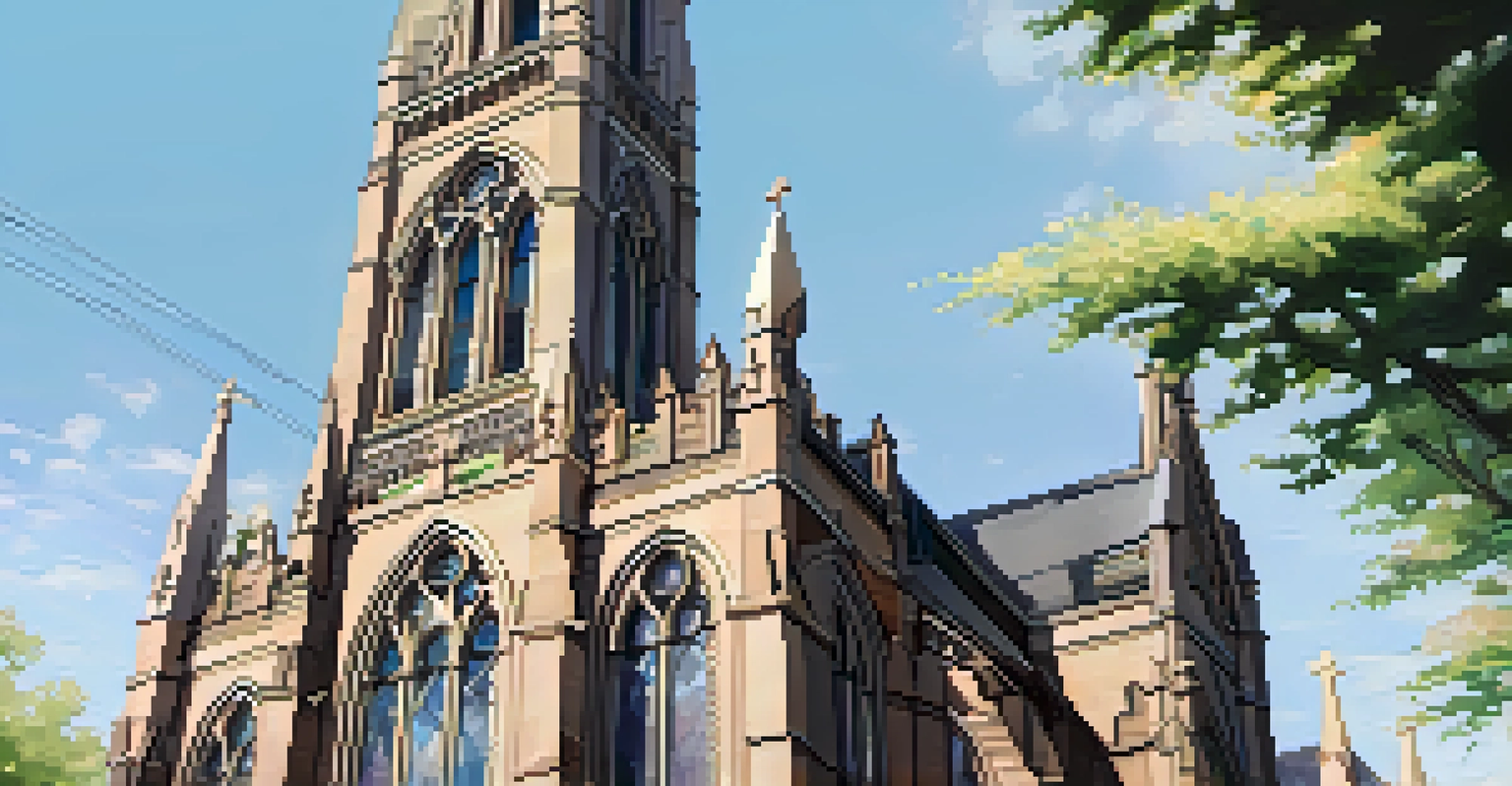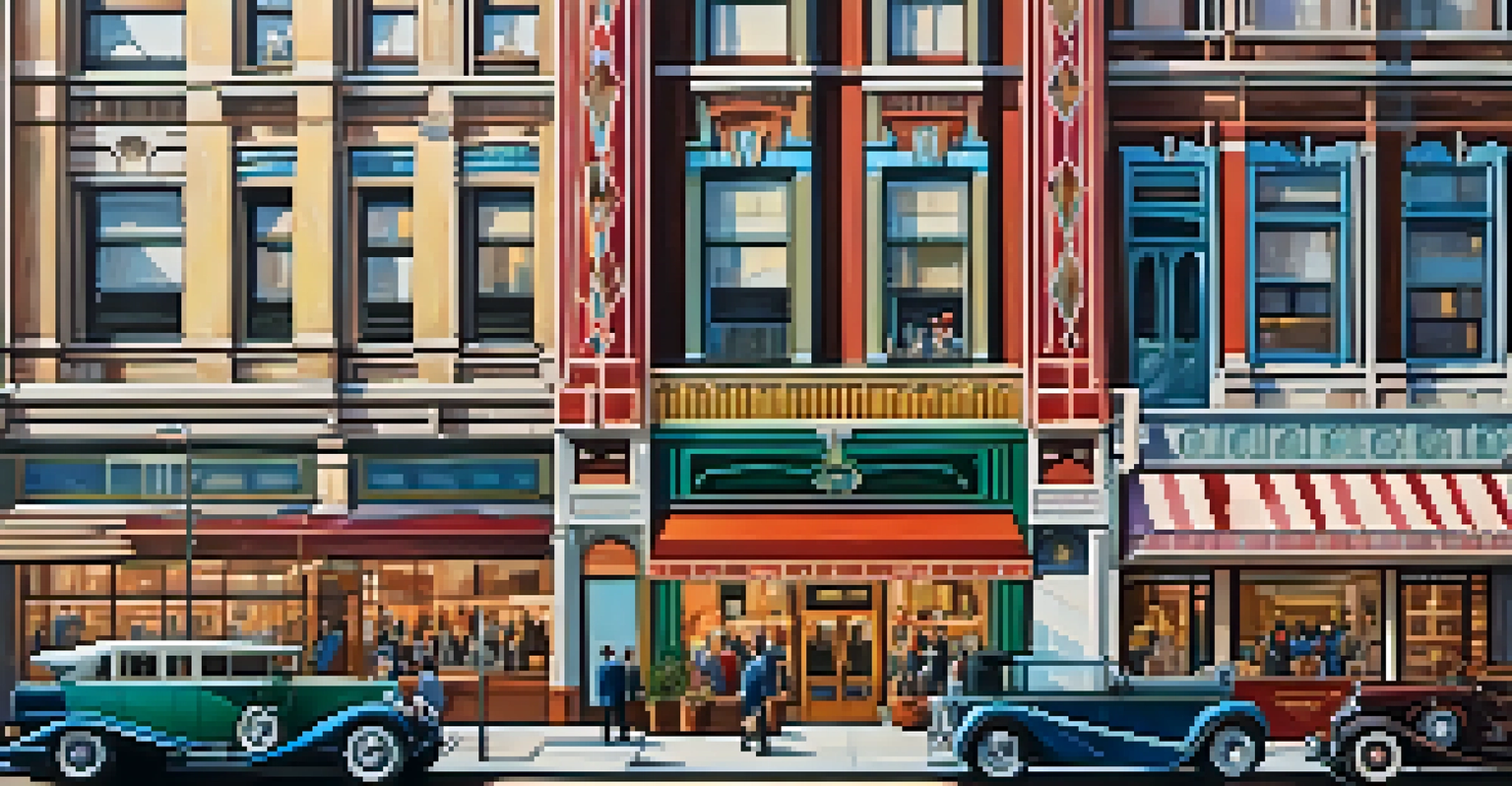Architectural Styles of Jersey City's Historic Buildings

The Charm of Brownstone Architecture in Jersey City
Brownstones are a hallmark of Jersey City's architectural landscape, exuding charm and historical significance. These elegant, multi-story townhouses, typically made from brown sandstone, reflect the prosperity of the city during the 19th century. As you stroll through neighborhoods like Journal Square, you can’t help but admire their intricate details, from ornate cornices to grand stoops.
Architecture is the art of how to waste space.
Many of these brownstones have been lovingly preserved, offering a glimpse into the lifestyle of the past residents. The homes often feature large windows and spacious interiors, ideal for families during the height of their popularity. Today, they serve as both residences and cultural landmarks, bridging the gap between Jersey City's rich history and its modernity.
Visitors and locals alike are drawn to the warm hues and unique architectural features of brownstones, making them a beloved part of the city's identity. They stand as a testament to the craftsmanship of the era, inviting us to imagine the stories that have unfolded within their walls. This architectural style contributes significantly to the overall character of Jersey City.
Gothic Revival: A Touch of the Dramatic
The Gothic Revival style brings a sense of drama and grandeur to Jersey City's architectural scene. Characterized by pointed arches, intricate facades, and detailed ornamentation, this style often evokes feelings of medieval European architecture. Structures like the iconic St. Paul's Episcopal Church exemplify these traits, standing proudly with their stunning stained glass windows.

This style was particularly popular during the 19th century as cities sought to convey a sense of permanence and spirituality. The churches and public buildings constructed in this style often serve as focal points within their neighborhoods, drawing the eye with their towering spires and detailed craftsmanship. Walking through these areas, you can feel the weight of history and the artistic expression that shaped the city.
Jersey City's Architectural Diversity
The city showcases a rich variety of architectural styles, from charming brownstones to dramatic Gothic Revival buildings, reflecting its historical and cultural evolution.
Gothic Revival buildings in Jersey City not only enhance the skyline but also enrich the cultural fabric of the community. They invite admiration and contemplation, encouraging us to appreciate the artistry that went into their creation. These structures are more than just buildings; they are landmarks that connect us to the past.
Art Deco: A Celebration of Modernity
Art Deco architecture made its mark on Jersey City in the early 20th century, embodying the spirit of modernity and innovation. With its bold geometric shapes, vibrant colors, and decorative motifs, this style represents a shift away from traditional forms. The Jersey City Medical Center, with its striking facade, is a prime example of Art Deco’s influence in the area.
The details are not the details. They make the design.
This architectural style often celebrates the achievements of the industrial age, reflecting the optimism of the time. During the 1920s and 1930s, Art Deco buildings became symbols of progress, showcasing advancements in design and technology. The unique characteristics of this style can be found in various public buildings and theaters throughout the city.
Art Deco structures in Jersey City capture the essence of an era defined by change and excitement. They stand out among the more traditional styles, offering a vibrant contrast that highlights the city's diversity. As you explore these buildings, you can feel the energy that Art Deco brought to the urban landscape.
Neoclassical Buildings: Timeless Elegance
Neoclassical architecture in Jersey City exudes timeless elegance, often drawing inspiration from ancient Greece and Rome. Characterized by grand columns, symmetrical shapes, and elaborate details, this style aims to convey a sense of permanence and dignity. The Jersey City Hall is a stunning example, showcasing a majestic portico that invites admiration.
This architectural style became prevalent in the late 19th and early 20th centuries, reflecting the aspirations of a growing city. Neoclassical buildings often serve as important civic landmarks, embodying the values of democracy and civic pride. Their imposing facades and classical elements create a sense of grandeur that continues to impress residents and visitors alike.
Preservation of Historical Heritage
Efforts to preserve Jersey City's architectural legacy are crucial for maintaining its unique character and honoring the stories tied to its historic structures.
The Neoclassical structures in Jersey City not only enhance the beauty of the city but also serve as a reminder of its rich history. They represent a cultural heritage that values art and architecture as integral parts of community identity. As we appreciate these timeless buildings, we also honor the visionaries who designed them.
Queen Anne Style: A Blend of Elegance and Whimsy
Queen Anne architecture adds a touch of whimsy and charm to Jersey City's historic buildings. Known for its asymmetrical facades, decorative gables, and diverse materials, this style often evokes a sense of playful elegance. Many residential homes in neighborhoods like the Heights showcase this delightful architectural style, with their intricate woodwork and vibrant colors.
The Queen Anne style emerged during the late 19th century, reflecting a departure from the rigid forms of earlier architectural movements. Homeowners embraced creativity, incorporating unique design elements such as turrets and wraparound porches. This allowed for personal expression and made each home distinct, contributing to the neighborhood's character.
As you explore these charming homes, it’s easy to be enchanted by their storybook quality. They invite you to imagine the lives of those who once called them home, each house with its own narrative. The Queen Anne style enriches Jersey City's architectural diversity, reminding us of the importance of creativity in our built environment.
Industrial Architecture: The Backbone of Progress
Jersey City's industrial architecture tells the story of its transformation from a bustling port city to a modern urban center. Characterized by large warehouses and factories, this style is often marked by functional design and robust materials like brick and steel. The remnants of these structures, like the Central Railroad of New Jersey Terminal, showcase the city’s historical significance in trade and transportation.
During the late 19th and early 20th centuries, these industrial buildings played a crucial role in the city’s economy. They were designed to accommodate heavy machinery and high volumes of goods, reflecting the demands of the industrial age. Today, many of these structures have been repurposed into trendy lofts and cultural spaces, breathing new life into their historical bones.
Cultural Significance of Architecture
Each architectural style in Jersey City, such as Art Deco and Mission Revival, contributes to the cultural fabric and identity of the community.
The blend of old and new in Jersey City’s industrial architecture highlights the city’s ongoing evolution. It serves as a reminder of the hard work and innovation that built the community we see today. By preserving these structures, we honor the past while embracing a future that values historical context.
Mission Revival: A Nod to Religious Heritage
Mission Revival architecture in Jersey City offers a glimpse into the religious and cultural heritage of the area. Inspired by the early Spanish missions, this style features stucco walls, red tile roofs, and arched doorways, creating a warm and inviting atmosphere. One notable example is the St. Anthony of Padua Church, which showcases these beautiful design elements.
This architectural style gained popularity in the early 20th century, as communities sought to create spaces that reflected their cultural roots. Mission Revival buildings often serve as centers for community gatherings and religious ceremonies, solidifying their importance in the social fabric of Jersey City. Their earthy colors and organic forms connect residents to a shared history.

As you admire Mission Revival structures, it’s easy to appreciate their role in fostering a sense of belonging. They reflect the diverse influences that have shaped the city's identity over time. The style not only enhances the architectural landscape but also embodies the values and traditions of the communities that built them.
Preservation Efforts: Maintaining Jersey City's Architectural Legacy
Preserving Jersey City's architectural heritage is vital to maintaining its unique character and history. Various organizations and local government initiatives work tirelessly to protect and restore historic buildings, ensuring that future generations can appreciate their beauty. Efforts include advocating for landmark status and securing funding for restoration projects, showcasing the community's commitment to its past.
These preservation efforts are not just about keeping old buildings standing; they are about honoring the stories and memories tied to these structures. By maintaining architectural diversity, Jersey City can celebrate its rich history while embracing modern development. This creates a vibrant environment where history and innovation coexist harmoniously.
As residents and visitors engage with these preservation efforts, they are reminded of the importance of heritage in shaping identity. Supporting local initiatives fosters a sense of pride and connection to the community. Together, we can ensure that Jersey City's architectural legacy continues to inspire and captivate for years to come.